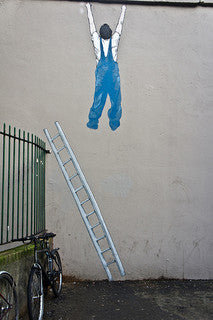The Unseen Dangers of Ladders in the Workplace

The Unseen Dangers of Ladder Usage in the Workplace
The majority of ladder injuries in the workplace are caused by falls, but workers can also get injured anytime during the processes of carrying, moving, lifting or simply placing the ladder on the ground.
A risk assessment should be conducted every time you use a ladder in the workplace to ensure the safety of onsite workers. Careful planning and supervision needs to be in place before a ladder can be deployed, especially in risky procedures onsite. To avoid unnecessary dangers, use ladders for the way they were intended and only for low risk, short duration tasks or in situations where the existing features of the site cannot be utilised.
Follow These Tips For Safe Ladder Usage
Firstly, it’s important to consult with workers directly involved with any task involving a ladder. Based on their knowledge and experience, you will be able to assess the types of risks associated with workers using a ladder.
From a workers perspective, always inspect the safety and health records of the firm to know how susceptible the workplace is to accidents from ladder usage. Ensure that all ladders used in the workplace are from reputed manufacturers. Ladders must bear the right industrial markings, load rating, usage rating and other specifications to meet compliance.
Maintenance and inspection of the ladders should be done at regular intervals. The maintenance team will ensure that ladders are not placed in exposed areas and are free from wear and tear. They must also be inspected after each use to assess if any part is at risk. If these formalities are not followed, it could prove to be hazardous for workers; ladder accidents are one of the most common on worksites.
Ladders made of metal should be fitted with anti-skid materials and all locks on the ladder have to be checked before usage. Any defect in the ladders, once identified, must be immediately repaired or replaced with components of similar quality and design.
When using the ladder, confirm that it’s placed on a solid and level surface before climbing. In the case of a single ladder, verify that it is attached securely or has a person at the base, holding it steadily. The ladder must always be long enough to exceed the point of access. Do not place the ladder near doorways, driveways, power lines or on uneven ground – doing so will almost ensure a fall.
While working outdoors, ensure that it’s not exposed to strong winds and other unfavorable weather conditions.
Never allow more than one person to ascend the ladder at a time. While climbing, ensure that you always face the ladder, maintain three points of contact and wear appropriate footwear. Do not carry anything in your hands. Carry tools and other equipment in a pouch or tool belt. Also make sure that you don’t carry anything beyond your capacity as it could cause you to lose balance and hurt yourself.
If you are using a stepladder, always ensure that it is in the fully open position. The side braces and cross braces of the stepladder must be locked before climbing.
When ladders are used to gain access to elevated work platforms, rooftops or inspection points, ensure that guardrails are provided and fall-arrest systems are in place. Trestle ladders should be authorized for light duty work only. While using the ladder outdoors, ensure that the work area is barricaded to avoid disturbances from traffic and public.
Finally, it’s important to train and update staff with the relevant safety and emergency measures at each workplace. Employees and contractors need to have easy and immediate access to emergency services with only experienced personnel entrusted with high-risk tasks.
To ensure that your ladder is always secured, try using a ladder grip like the Lock Jaw Ladder Grip. Available in the USA and Australia, this leading grip is backed by a 30-day money back guarantee, so you having nothing to lose in trying it.


